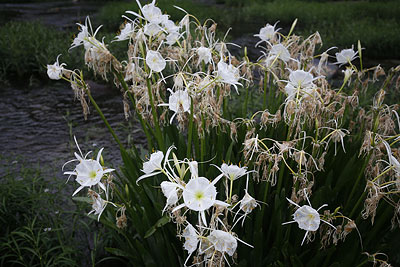Taking good photos of Cahaba lilies is a
challenge for any photographer and it starts with being there at
optimal times. The best times at the Cahaba River NWR and
Hatchet Creek is the second, third and fourth week of May,
depending on weather conditions. On May 8 2017 there were an
abundance of lilies but on the same date in 2018 there were far
fewer, probably because we had a cold spring and a lot of rain.
If you go in the season, like the second week of May, there will
be less lilies but likely more pristine.The later in the season
you go, the more dead, weathered and ragged flowers you may
find. If we don't have periods of heavy rain to beat them down
you can still take good photos late in May and even into June.
Unless you come in early morning, weekends at the Cahaba River
NWR get crowded with people. At peak times you'll encounter
traffic on the one lane road and you'll have a hard time finding
a convenient place to park. The third Saturday of May, the day
of the Cahaba Lily Festival would not be the best time for
photography because people are shuttled in to see the lilies.
The Cahaba lily is a delicate subject and you often find them
weathered and ragged. Wind and a full day of sun will make
their mark on them. A heavy rain will utterly destroy their
delicate beauty. In early morning they are in their most
pristine condition because they begin to bloom late in the day
and open at night. Once they die they are left hanging
among the fresh, beautiful ones.

Dead lilies late in the season or a couple days after heavy
rain.

In this photo fresh blooms are ready to open among the ragged
ones which will soon die and turn brown. If you take photos of
the lilies from a distance then some dead ones are acceptable
but if you want closeups you need to be there before they
become weathered or dead. If you are working in black &
white, a few dead ones in the mix are acceptable because the
ugly brown won't show up.

Clean looking closeups have to be taken before dead lilies
start to appear among the fresh ones.
Most lilies are out in the open and on a sunny day that offers
challenges for a photographer. Of course early morning or late
afternoon offers the best lighting. If it's a cloudless day I
would be finished by 10:00 or so and not stick around in the
glaring sun. Another consideration is motion. The less wind the
better. On most days lilies are in constant motion even from the
slightest breeze and working close up means using a fast shutter
speed to prevent blur. Since that requires a wide f/stop or a
high ISO, it is difficult or impossible to get the ultimate
photos. Closeups of Cahaba lilies are a technical as well as an
artistic challenge.



